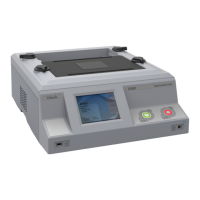C H A P T E R 7 – T E S T S A N D T E S T C O N D I T I O N S
AT5600 User Manual 98-119 issue 14 Page 138
7.29. HPAC - AC HI-POT (EHT)
Where Used
Hi-Pot or EHT testing (to check for insulation breakdown between windings or
between windings and the screen or core) is often specified for power line
transformers or for switched mode power transformers in applications where
safety is important.
It is typically performed between all primary windings connected, and all
secondary windings plus the screen connected.
Specifying the Measurement
During the test, an AC voltage is applied across two groups of windings with the
windings in each group being shorted together. The voltage and current are
monitored throughout the dwell time; if either the test voltage cannot be
maintained, or the current is too large, then a failure will be recorded.
In programming the AT5600 you may select the voltage (from 100V to 5kVrms),
the frequency (50Hz / 60Hz at the full voltage, or up to 1kHz at reduced voltage),
the current trip level (10A to 30mA peak), and the ramp up and dwell times, all to
suit the specification of the transformer under test.
Many transformer specifications require Hi-Pot testing to be carried out with a
dwell time of 60 seconds. Although the transformer must be designed and
constructed to meet this, it is common practice to reduce the dwell time for
production testing.
This is recognized by IEC 742, which permits a dwell time of 2 seconds for
production testing. Although not required by IEC 742, it is good practice to
increase the test voltage by at least 10% when performing reduced-time testing,
to provide additional security for the test.
IEC742 has been replaced by IEC61558, which specifies 1 second for production
testing. Details are available on the IEC web-site (http://www.iec.ch).

